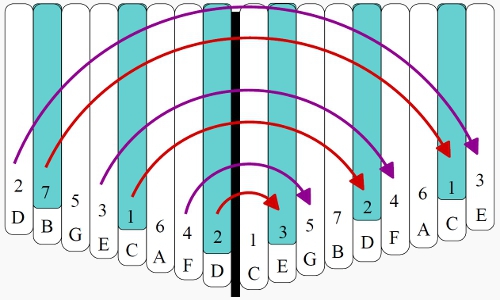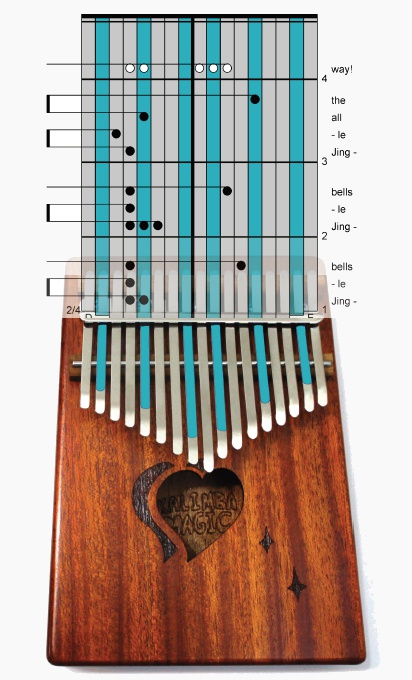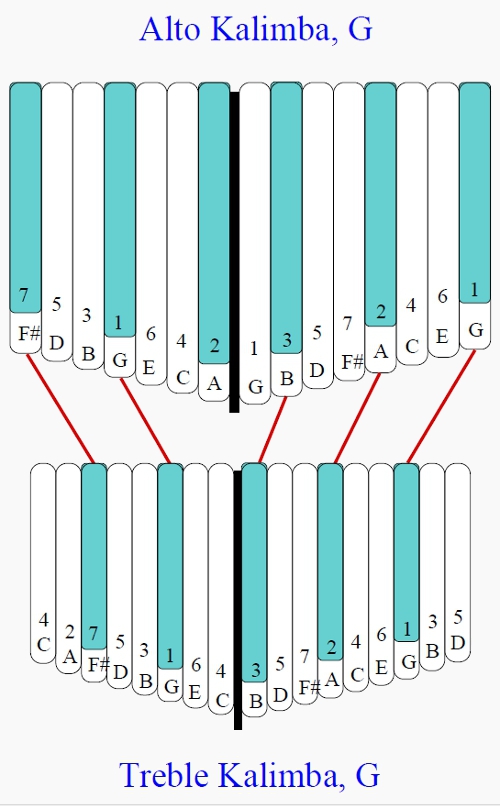My idea of kalimba playing perfection is being able to know exactly where every tine is on my kalimba without looking. To be able to leap across from one side to the other, or to be able to jump large intervals from a low tine to a high tine… perfectly! To be able to play amazingly, quickly, accurately, and crisply, all by feel and memory.
Ah, it’s a lovely dream. But after playing for 33 years, I still like to rely on visual cues to help me keep my place and find my way on the kalimba.
This blog post describes five different ways in which painted tines provide visual cures to help you play better kalimba.
“Why are some of the tines painted?” People ask me this all the time. Many assume it is like white notes and black notes on the piano. That’s not it, since most kalimbas are diatonic and have only piano’s “white notes”. What about chromatic kalimbas? They have their “black notes” on the back side. Painted tines on the kalimba have different meanings that are unrelated to chromatic notes.
(1) Basic Navigation. The main reason why some of the tines are painted is due to a very early design consideration made by Hugh Tracey. His first kalimbas had 17 unpainted tines. This is a lot of tines, and it’s very easy to get lost among them. Tracey figured by painting every third tine, that would give you plenty of landmarks. So, the painted tines help you find your way on the kalimba. If a song starts on a painted tine, remember that. If a phrase starts one tine higher than a painted tine, remember that.

(2) Left-Right Integration. One of the consequences of the consistent way the Hugh Tracey kalimbas are painted is that the colored tines also help you interface the left side and the right side of the kalimbas. It is really easy to play tines on just one side of the kalimba – you can go up and down, and you never really get lost. However, let’s say you are playing a note on the left side – let’s say the left (painted) C in the middle of the left side. If you need to go up to the next note higher, you need to cross over to the other side to find that note. Crossing over means picking out a tine a long way from the first tine you played, and it is a hazardous journey, fraught with peril… unless you take the painted tine expressway.
Note: this article uses the new C-tuned 17-Note kalimbas as a specific example. All of these uses of painted tines apply generally to other kalimbas with different tunings, though the exact note names will be different.
Every painted tine on the left has a painted counterpart on the right, one degree higher in the scale. The lowest painted tine, D, on the left, has a corresponding painted tine, E, one step higher in the scale, on the right. Such painted tine pairs are indicated with red arches.
This system extends to every tine – take the low F on the left for example. Think of it as “one higher, one to the left of the painted D.” Now, the F’s corresponding higher note on the right will be G, which is “one note higher, one to the right of the painted E.” Such “one tine higher” pairs are indicated with purple arches. And the next higher-up tines? We haven’t put any arches on them, but you could think of them as “one lower than a painted tine.”
And finally, the icing on the cake: the lowest tine on this kalimba, C, is the root note. It is a very special tine indeed. I think of the two neighboring low tines, painted D and painted E – and really, all of the painted tines on this kalimba – as making a big BULLSEYE pattern that calls special attention to the center note.
 (3) Tablature to Kalimba. This one is my personal contribution to the meaning of the painted kalimba tines. My kalimba tablature (I invented it in 2004) reproduces those painted tines.
(3) Tablature to Kalimba. This one is my personal contribution to the meaning of the painted kalimba tines. My kalimba tablature (I invented it in 2004) reproduces those painted tines.
The tablature is like a map of the kalimba. The painted tines on the tablature should match the painted tines on your kalimba. If the tablature says “play this painted tine and the one just to the left of it,” that is easy to translate to the kalimba.
The tablature reads up the page – or, if you are a Dance Dance Revolution or Guitar Hero fan, imagine the tablature falling down the page, and you must play the notes indicated as they come down to your kalimba.
You may think that you do not need tablature and “you can do this without it” – and there is a lot of progress you can make without the tablature. But I assure you that in my 33 years of playing, I have thought of some things that you will not think of for a long time. For example, consider the pictured arrangement of “Jingle Bells.” It has melody notes, harmony notes, a counterpoint line, and a full chord. This is complicated, but the tablature shows you exactly how to achieve that music.
So, every time I write out an arrangement for a song or create a new book or download, I am working with the very-important pattern of painted tines on the kalimba.
 (4) Relating Different Kalimbas to One Another. The painted tines can help two kalimbas play together. For example, if you have a Hugh Tracey Alto kalimba in G, 15 notes, with G as the lowest note… and your friend has a Hugh Tracey Treble kalimba in G, with 17 notes, and B as the lowest note… you can watch each other playing, and you can know exactly what your friend is playing… because the painted tines match up. Even though the treble has two unpainted tines higher on the left and right sides, the painted tines match up perfectly.
(4) Relating Different Kalimbas to One Another. The painted tines can help two kalimbas play together. For example, if you have a Hugh Tracey Alto kalimba in G, 15 notes, with G as the lowest note… and your friend has a Hugh Tracey Treble kalimba in G, with 17 notes, and B as the lowest note… you can watch each other playing, and you can know exactly what your friend is playing… because the painted tines match up. Even though the treble has two unpainted tines higher on the left and right sides, the painted tines match up perfectly.
By the way, I have been making something of a fuss. Several Chinese companies have started making 17 note kalimbas, and they tend to recommend the 5-tine painting system of the Hugh Tracey Treble (17 note) kalimba. However, the Chinese 17-Note kalimbas are tuned differently, with the root in the bass. Sorry, I am sticking my feet in the earth and growing roots on this one: if only 5 tines are painted on a 17-note kalimba, that is implying the lowest note is the 3rd of the scale. When I paint a 17-note kalimba that has been tuned with the root note (the “1” note) as the lowest tine, I do not paint the lowest tine, but I do paint the lowest tine’s neighbors.
Why am I such a stickler on this point? Because it is consistent with the system of some 25 books and 50 instructional downloads I have created over the last 14.5 years. That is a lot of weight, and I am behind it 100%.
(5) The Painted Tines Make a Generic System That Works For Many Kalimbas in Different Keys. The video below illustrates one particular use of the painted tines – when you get accustomed to the pattern they make, your songs are referenced to that pattern of painted and unpainted tines. You can pick up another kalimba in a totally different key, but still painted within this system, and you can still play most, or all, of your songs.
Now, you may be asking: what is the difference between RED or BLUE or GREEN? The answer is that there is no difference. The color can be whatever you want. If your kalimba does not have painted tines, I suggest you go to your pen collection and select out a Sharpie marker. If you don’t like the color, go get a good color at the office supply store. And then color on the appropriate five or six tines in whatever color you want. The Sharpie marker will wipe off easily with alcohol wipes.
On the other hand, Kalimba Magic takes great pride in carefully and accurately painting the tines that should be painted for you to get the most out of your kalimba playing. And we have a new color that you can ask for explicitly (in the comments field) when you order: classic light blue, the shade of blue that was used on Hugh Tracey kalimbas in the 1960s and 1970s.


Sign up for our newsletter and free resources with your email address:
We pinky promise not to spam you and to only send good stuff.
 Christmas in July 2025
Christmas in July 2025 Patriotic and American Music for Kalimba
Patriotic and American Music for Kalimba